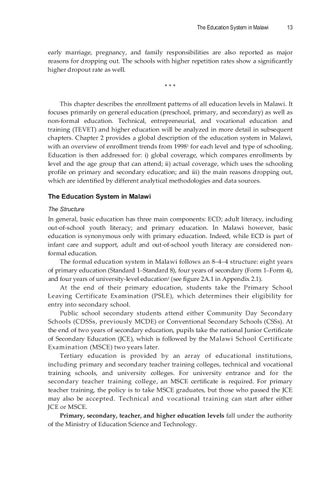The Education System in Malawi
13
early marriage, pregnancy, and family responsibilities are also reported as major reasons for dropping out. The schools with higher repetition rates show a significantly higher dropout rate as well. * * * This chapter describes the enrollment patterns of all education levels in Malawi. It focuses primarily on general education (preschool, primary, and secondary) as well as non formal education. Technical, entrepreneurial, and vocational education and training (TEVET) and higher education will be analyzed in more detail in subsequent chapters. Chapter 2 provides a global description of the education system in Malawi, with an overview of enrollment trends from 19981 for each level and type of schooling. Education is then addressed for: i) global coverage, which compares enrollments by level and the age group that can attend; ii) actual coverage, which uses the schooling profile on primary and secondary education; and iii) the main reasons dropping out, which are identified by different analytical methodologies and data sources.
The Education System in Malawi The Structure
In general, basic education has three main components: ECD; adult literacy, including out of school youth literacy; and primary education. In Malawi however, basic education is synonymous only with primary education. Indeed, while ECD is part of infant care and support, adult and out of school youth literacy are considered non formal education. The formal education system in Malawi follows an 8–4–4 structure: eight years of primary education (Standard 1–Standard 8), four years of secondary (Form 1–Form 4), and four years of university level education1 (see figure 2A.1 in Appendix 2.1). At the end of their primary education, students take the Primary School Leaving Certificate Examination (PSLE), which determines their eligibility for entry into secondary school. Public school secondary students attend either Community Day Secondary Schools (CDSSs, previously MCDE) or Conventional Secondary Schools (CSSs). At the end of two years of secondary education, pupils take the national Junior Certificate of Secondary Education (JCE), which is followed by the Malawi School Certificate Examination (MSCE) two years later. Tertiary education is provided by an array of educational institutions, including primary and secondary teacher training colleges, technical and vocational training schools, and university colleges. For university entrance and for the secondary teacher training college, an MSCE certificate is required. For primary teacher training, the policy is to take MSCE graduates, but those who passed the JCE may also be accepted. Technical and vocational training can start after either JCE or MSCE. Primary, secondary, teacher, and higher education levels fall under the authority of the Ministry of Education Science and Technology.
